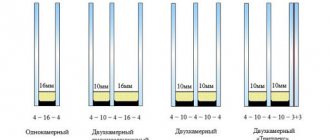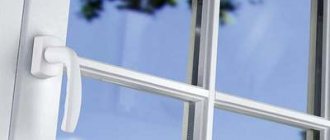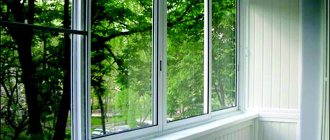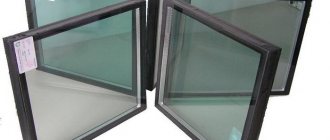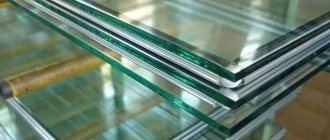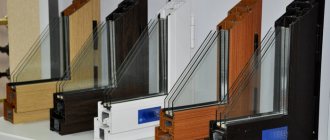Glazing based on PVC profiles is the most common method in which you can select elements with characteristics suitable for specific conditions. The correct choice of double-glazed windows is important, since it occupies the main part of the structure - up to 80%. So we'll find out what it means single-chamber or double-chamber double-glazed windows, what is the difference between them, and which option is better to install in a house or apartment. To draw a conclusion, let’s compare the designs and find out the difference in thermal conductivity and other parameters.
Features of the single-chamber package
A single chamber package is a two-pane glass system with a space between them that can be filled with air or an inert gas. The distance between the sheets depends on the thickness of the spacer frame installed around the perimeter of the structure.
Inside the frame there is an absorbent that absorbs moisture and prevents the formation of condensation. The glass is attached to the frame using a special sealant. For tightness, external elements are treated with polysulfide mastic.
The standard package thickness is 24 mm, of which:
- two glasses of 4.0 mm = 8.0 mm;
- frame width – 16.0 mm.
In some models, the distance between the glass may be 32.0 mm. There are also options 4/8/4 and 4/14/6.
The thermal conductivity index, depending on the thickness of the glass sheet, ranges from 2.732 to 1.981 W/m2K. When using an energy-efficient coating and filling the space between the chambers with the inert gas argon, the 1-chamber package becomes energy-saving in its characteristics.
Single-chamber energy-saving double-glazed window
Windows with such devices appeared relatively recently. Structurally, they differ little from conventional products.
Its peculiarity is as follows:
- The chamber is filled with inert gas , the thermal conductivity of which is almost two times lower than the thermal conductivity of air.
- One of the glasses is coated with a special composition that reduces the thermal conductivity of the glass.
Such features significantly reduce heat exchange from the room to the external environment.
The service life of the energy-saving package is 6-10 years, after which it gradually turns into a regular single-chamber package and continues to serve as such.
Features of double glazing
The design of the 2-chamber package includes three glasses mounted on a spacer frame with perforation. The glass sheet, which is located in the middle, is almost invisible. How to understand how much glass there is in a window, you can use a candle or a lighter. If three reflections are obtained, then the package has two cameras.
Silicone or polyurethane sealant is used to seal the structure. Its formula includes five elements. How to determine the thickness of the package in this case? It is necessary to sum up the thickness of the glass and the distances between them.
This type can be symmetrical or asymmetrical; the most common formulas are:
- 4/6/4/6/4;
- 4/10/4/10/4;
- 6/8/4/8/6.
The standard glass thickness is 4.0 mm; to increase sound and heat insulation, the first and second elements are made thicker. The most popular products are 32.0 and 40.0 mm. The weight of a package with 2 cameras is approximately 1.5 times greater compared to a 1-chamber package of the same size.
Characteristics of single-chamber double-glazed windows
Many people, seeing the name “single-chamber”, assume that such a double-glazed window is completely no different from a regular window frame with one glass. This is an erroneous statement. In all types of double-glazed windows, the chamber consists of two glasses separated by an aluminum frame and creating a hollow space between them. This space is usually filled with dried air and an absorbent that absorbs remaining moisture. But the number of cameras can reach three, so there will be four glasses in such a window.
So what is the difference between a single-chamber double-glazed window? Its advantages:
- Due to its light weight, a window with a single-chamber double-glazed window does not create unnecessary load on the fastenings and the structure of the opening. Such windows do not fail longer;
- Transmits up to 80% more light. At first glance, this difference is almost never noticeable, but visually a well-lit room appears larger;
- Single-chamber double-glazed windows, the glass of which is coated with silver on one side, and the chamber is filled with argon instead of air, are energy-saving. Such windows retain heat no worse than double-chamber ones;
- Lower price. Such a double-glazed window costs on average 15-20% less than a two-chamber one. This indicator is not so large, but often plays a decisive role when choosing a double-glazed window.
Single-chamber double-glazed windows also have disadvantages:
- Low sound insulation. These double-glazed windows can reduce noise levels by only 32 dB;
- They are also characterized by a low coefficient of heat transfer resistance. This means that condensation on the glass of a single-chamber double-glazed window will form at a temperature of about -8 degrees Celsius;
- The heat transfer resistance of double-glazed windows with one chamber is lower by a third compared to double-chamber ones;
The thickness of the single-chamber package depends on the size of the spacer frame and varies from 1.8 to 3.6 centimeters. At the same time, the standard thickness used in most construction companies is 2.4 centimeters.
The standard thickness of glass in a double-glazed window is 5 millimeters, but when using glass 6 millimeters thick, you can achieve the same thermal conductivity characteristics as double-glazed windows.
What are the differences between single-chamber and double-glazed windows?
The main difference between a single-chamber double-glazed window and a double-chamber one is the following parameters:
- number of glasses – 2 and 3;
- number of cameras – 1 and 2;
- weight, frame width.
How warmer a particular type is depends on the characteristics of the glass. For example, a 1-chamber model with energy-efficient spraying has higher thermal insulation characteristics compared to a standard window with two chambers. Thus, the difference in the degree of thermal protection is determined by the presence of an energy-efficient coating.
We found out how to distinguish different windows - by the number of reflections. But, when ordering, you can see what the sample looks like in cross-section and request documentation. The difference in price depends on the manufacturer and model parameters.
How to determine the number of cameras?
So, you have installed the plastic profile. The manager assured you that your apartment now has a good double-glazed window. And so you come to the window, and what do you see? Two glasses. The thought immediately comes to you that you have been deceived. Don't rush to conclusions. We will tell you how to distinguish a window consisting of one or two cameras.
To do this, you need to perform a simple action. Light a match or lighter a couple of centimeters from the glass unit. You will see the reflection of lights in the window. Count how many there are. If there are two, then you have a cheap single-chamber option, if there are three, then a two-chamber option. Each glass reflects a light, respectively, 2 lights are 2 glasses in a single-chamber design, and 3 lights are 3 glasses in a two-chamber design.
This method will allow even a non-specialist to distinguish the difference. And you can easily determine which window is in front of you.
Don't know which double-glazed windows to choose? Our company is always happy to provide qualified advice on the difference between models with one or two cameras. has been producing and installing PVC profiles for quite a long time. We use high-quality materials, and all work is performed by highly experienced craftsmen. As a result, no matter what choice you make, you will certainly be satisfied with the result of our cooperation. Call now!
Where is single glazing used?
It is recommended to install windows with a standard model of the basic configuration in regions with a winter temperature of at least -5.0 degrees. They are mainly used for glazing:
- Balconies and loggias. Such a system is sufficient to protect against wind, dust and precipitation, and if the space is used as a living room, then a more effective solution will be needed. Due to the low weight, a high load is not created on the load-bearing elements.
- Balcony block. If the balcony is glazed, then double-glazed glazing is enough to separate it from the living room.
- Summer kitchen, dacha. As a rule, such buildings are used in the summer, so it is not advisable to install massive expensive systems.
- Non-residential premises. This could be a warehouse, storage room or technical room without heating.
Which glass unit is better?
To determine which windows are best for you, you need to take into account the characteristics of the room, the type of building and climatic conditions.
A single-chamber window is used in the following situations:
- Glazing of a loggia or balcony. However, if you want to arrange a living room or winter garden here, it is better to pay attention to warm structures.
- Country house, gazebo. If you only use the premises in the summer, there is no point in paying extra. In summer, additional thermal protection is completely unnecessary.
- Warm climate. If you live in a region where sub-zero temperatures are rare and the thermometer usually stays above zero almost all year round, a single-chamber option is sufficient. But in this situation it is worth taking into account the sounds coming from the street. Residents of a house facing an avenue, stadium or noisy part of the city should choose two cameras.
It is worth choosing double-chamber warm double-glazed windows under certain conditions:
- Cold climate. If your region has fairly severe winters, then double-glazed windows will help make your house or apartment much warmer. In such situations, even heating does not always help, so a good window with energy-saving glass will help retain heat.
- The balcony is a continuation of the room. In this case, it is also recommended to choose a two-chamber product.
Pros and cons of single window
Advantageous characteristics include:
- light weight, low load on supporting structures and fittings, possibility of installation in old houses;
- good light transmittance - up to 80.0%, inside the room there is natural lighting that is comfortable for vision;
- silver plating and filling the interchamber space with inert gas make such a window energy efficient;
- in basic configurations the price is 20% lower than for a two-chamber one.
Main disadvantages:
- low level of sound insulation – up to 32.0 dB;
- low coefficient of resistance to heat transfer, due to which condensation can form at temperatures below -8.0 degrees.
What is the difference between a 32 mm double glazed window and a 40 mm double glazed window?
January 07, 2020
Whatever you say, every year customers of modern plastic windows are becoming more and more literate and savvy in matters of choosing decent window designs for their home, apartment or office. For example, the question of how many cameras they want to see in the double-glazed windows they order will not surprise anyone. Everyone knows that single-chamber double-glazed windows are cold, and two- and three-chamber double-glazed windows are warm. The same can be said about specialized energy-saving glasses and filling the glass unit chambers with inert gases. Many customers already know that such measures will help make the window much warmer. And, as you know, there is never too much heat.
And yet, “cunning managers” have one question up their sleeves that can stump even the most technically savvy client. We are talking about the thickness of the glass unit. So, if you ask a customer whether he wants a 32 mm double-glazed window or a 40 mm double-glazed window, he will probably fall into a slight stupor. And if you tell him that a thicker double-glazed window will not necessarily have a larger number of cameras compared to a thin double-glazed window, then the client may even require an “information reload.” That is why we decided that a small educational program on the issue of choosing the optimal thickness of a double-glazed window will certainly not be superfluous for you. Let's read and get enlightened.
Let's start with what the term “glass thickness” actually means. Many people confuse it with a term such as “the thickness of a plastic window,” but a plastic window does not consist of just one glass unit. There is also a plastic frame, fittings, window sills, ebbs, etc. So, if we talk about the thickness of the glass unit, then it is the glass unit itself that needs to be measured. You will be able to do this only if the double-glazed window is removed from the design of the plastic window, so you will have to take the managers’ word for it. The thickness of the glass unit is the distance from the outer glass of your window to the inner glass. Thickness is measured in millimeters. And if you are told that a 40 mm double glazed unit will be installed in your plastic windows, you will know for sure that 40 mm is the distance between the outer panes of the double glazing unit.
The main feature of the ability to vary the thickness of a double-glazed window is the expansion of the potential for increasing the thermal insulation and sound insulation characteristics of a plastic window by changing the design of the double-glazed window. Difficult? Let's try to explain it more simply. So, if in old windows a “double-glazed window” was simply a pair of glasses fixed in the structure of the window frame using wooden glazing beads nailed with nails, then a modern double-glazed plastic window is a much more complex and advanced design. A double-glazed window is a hermetically sealed system consisting of several glasses, fixed from each other at a strictly specified distance and separated by spacer frames into chambers (closed spaces between the glasses). And each parameter of this system, be it the number of glasses, the distance between the glasses, the thickness of the glasses, the type of glass and the filling of the chambers, will be of decisive importance for the insulating characteristics of both the double-glazed window and the plastic window. Accordingly, the thicker the double-glazed window, the greater the possibilities for combining the above-mentioned characteristics will be available to the customer.
A small example. The widespread design of a 32 mm double-glazed window is a design like 4-10-4-10-4.
That is, three glasses 4 millimeters thick, plus two cameras 10 millimeters each.
Taken together, this amounts to the coveted 32 millimeters. As for 40 mm double-glazed windows, here, for example, the 4-16-4-12-4 scheme can be used.
A non-standard increase in the width of the chambers makes it possible to achieve a noticeably greater increase in both thermal insulation and sound insulation. Any specialist will tell you that the difference in the distance between the glass guarantees a significant reduction in resonant vibrations from the street, and if you add the difference in the thickness of the glass, the sound insulation can become maximum. So, the thicker the glass unit, the more variable the specified scheme can be, which promises a good increase in the parameters that you need.
We have already mentioned that the thickness of the glass unit may not affect the number of cameras in it. For example, it is quite acceptable that a client orders a 40 mm single-chamber double-glazed window, supplementing its thermal insulation characteristics by filling the chamber with inert gas, as well as using energy-saving glass or heated glass. And vice versa. You can order a 32mm double-glazed window, which will have two or even three chambers, with a minimum distance between the glasses.
What other parameters of a plastic window are affected by the thickness of the glass unit? For example, the weight of the structure. It is clear that the thicker the double-glazed window, and the more ingenious the design used in it, the heavier the overall design of the plastic window will be. That is why for warm glazing of balconies and loggias it is strongly recommended to use 32 mm rather than 40 mm double glazing. Another feature is the use of a specific profile system of double-glazed windows of a given thickness. Budget options for profile systems, as a rule, operate with 32 mm double-glazed windows, while more expensive options use 40 mm. This is also reflected in the total cost of the ordered structure, although, taking into account the possible difference in the schemes and features of the double-glazed window itself, it is impossible to make unambiguous judgments on this issue.
As a conclusion, we note that the thickness of the double-glazed window can really have a significant impact on the important characteristics of the ordered plastic window. Although we would not consider this indicator to be unambiguously decisive.
Services and service Warranty
- Guarantee
- Payment Methods
- Production time
- Calculator
- Order from A to Z
- Certificates and licenses
- January 17, 2020
Window in the bathroom for convenience and style
Would you like to have a window in your bathroom? This is exactly the question we asked ten of our clients to understand whether this topic is relevant in our time. The reaction to such a seemingly harmless question demonstrated a whole range of emotions - from bewilderment and rejection to enthusiastic readiness for such innovations. True, the young woman who expressed a desire to become the owner of such a window immediately added: “I really want it, but only in combination with a new bathroom. My tiny bathroom doesn't even have room for an extra hook, let alone an entire window. And where can it go? To the neighbor's bathroom?
- January 14, 2020
Is it worth installing heating on the loggia?
“Warm” plastic glazing on balconies and loggias is, of course, a benefit of modern civilization. Designs of this type are not only beautiful and comfortable, but also heat-, moisture- and noise-proof. By installing plastic glazing on your loggia, you will take a huge step towards creating another truly living space in your apartment. But you shouldn’t think that “warm” plastic glazing will bring you the coveted degrees of warmth on its own. Yes, such structures will prevent the penetration of cold air from the outside and the “evaporation” of internal heat from the loggia, but they definitely will not “warm” you. If you don’t have your own heat on your loggia, then plastic glazing will not give you it. In this regard, the question arises of the need to install heating systems and appliances on loggias, which we would like to consider in this article.
- January 03, 2020
How to recognize signals from your own windows
And although the idea that it’s time to change the windows, as a rule, comes to their owner somehow immediately, almost with lightning speed, this does not mean that every time you need to wait for just such a signal. And there is an explanation for this: such a thought is the final chord, fixing the irreversible changes that have occurred to the windows, which are no longer unnoticeable. Simply put, at one fine moment there comes a realization that it is no longer possible to delay making the only right decision.
- December 27, 2019
Expansion of the kitchen area due to the loggia. Live comfortably!
Agree that the presence of a loggia is an absolute plus for an apartment of any size, especially if you manage these additional square meters wisely. Of course, there is no universal option for such a “smart” solution, since the loggias have different sizes, configurations and locations, and, based on this, the purposes that they will be called upon to fulfill after the transformation can be completely different.
All news and publications
| Calculation of your project | or call a surveyor |
Advantages and disadvantages of double glazing
Key advantages:
- excellent thermal insulation, minimizing heat losses and energy consumption;
- effective protection from street noise;
- resistance to negative factors and long service life;
- When using multi-glass, protection is provided from cold in winter and from heat in summer.
Among the “disadvantages” it is worth noting:
- the width and weight of the glazing require a solid base for installation;
- light transmittance is 8.0% lower than that of double-glazed windows;
- depending on the characteristics, the price may be 30% higher.
Three-chamber double-glazed windows
Three-chamber double-glazed windows are often used in the north of Russia, and the closer to the pole, the more often. Its design already consists of four glasses with air chambers between them. And the width of the box of classic three-chamber plastic windows reaches 58-60 mm.
Three-chamber double-glazed window - only for northern latitudes
It is clear that the main advantage of the three-chamber system is its high heat and sound insulation. According to these indicators, such a thick window protects 50% better than double-glazed windows. But there is one “but”. This parameter will be significant if the cold outside the window is -40 in winter. If it is warmer, then the difference between two-chamber and three-chamber double-glazed windows is reduced.
A three-chamber double-glazed window also has disadvantages , which in some cases can cover its advantages. The glass is very heavy, but this does not make the entire structure any stronger. To strengthen it with a guarantee, you will have to present a few more requirements when ordering such a window. As a demanding person, either a wide profile or dividing the double-glazed window into several windows will suit you.
Relatively reduced light transmission is another disadvantage of the three-chamber system . Of course, if there are planes flying near your house, trains driving by and the cold is so bad that you can’t stick your nose outside, then you can’t even call it an inconvenience, because the main thing is warmth and silence. But if your home is calm and not cold, then you don’t need such a double-glazed window.
An important element of a window, in addition to the glass unit, is the fittings. Which brand to choose and not go wrong? Read in the material: Rating of furniture brands. There is also an article on the site about plastic window sills. There you will find out which company is best to order a window sill from.
If you are looking for a handle for a window, this article will help you decide.
What to look for when choosing double-glazed windows
Nowadays, there is a wide selection of plastic window designs. But among the abundance of choice, it is important not to make a mistake. When choosing, you should especially note:
- chamber number, their type;
- interchamber filler;
- thickness dimension.
Learn more about the above indicators.
Single-chamber or double-chamber apartments are installed in housing. Double-chamber ones cost more, have excellent sound insulation and energy-saving properties. First you need to analyze the location of the house, and only then choose a double-glazed window. Changes in size and thickness are reflected in improved performance. According to GOST, it is recommended to choose average indicators.
Today you can choose any glass, for example, with specific properties, reflective, tinted, mirrored, stained glass or frosted. Based on where your windows face and what you want from your window, you can significantly hide the shortcomings of the living space or its location, as well as emphasize the advantages. The filled space between the glasses also significantly affects the quality of the double-glazed windows. As a rule, filling is done with inert gases. A common gas is argon, it is practical and inexpensive. Argon's competitor is krypton, which, due to its high density, provides excellent heat and sound insulation.
Price of two-chamber Rehau windows with wood lamination
Rehau Blitz (New) laminated wood:
- On the one side;
- on both sides;
- in bulk
from 6056 ₽/m2
Window price
Rehau Grazio laminated wood effect:
- On the one side;
- on both sides;
- in bulk
from 6890 ₽/m2
Window price
Rehau Delight laminated wood effect:
- On the one side;
- on both sides;
- in bulk
from 7607 ₽/m2
Window price
Rehau Intelio 80 laminated wood effect:
- On the one side;
- on both sides;
- in bulk
from 7545 ₽/m2
Window price
Rehau Brillant laminated wood effect:
- On the one side;
- on both sides;
- in bulk
from 8138 ₽/m2
Window price
Rehau Geneo laminated wood effect:
- On the one side;
- on both sides;
- in bulk
from 15373 ₽/m2
Window price
What is the difference?
- Thickness directly depends on the number of glasses.
- Energy saving is directly proportional to the thickness of the product.
- Weight is a critical factor for large-sized metal-plastic windows.
- Transparency decreases with increasing number of glasses.
- Cost varies, but often not significantly.
Single bags are lighter than double ones - windows and doors with them are easier and more securely fixed in openings. 1-chamber products have 2 glasses, not 3, and they let in more sunlight. The double package is approximately 25% more expensive. There is a more important criterion for choosing windows - profile thickness. It must be durable and securely fix the glass bag.
+7
Call
Order windows at a profit!
Until the end of the week, 30% discount on windows and balconies!
I want a discount
